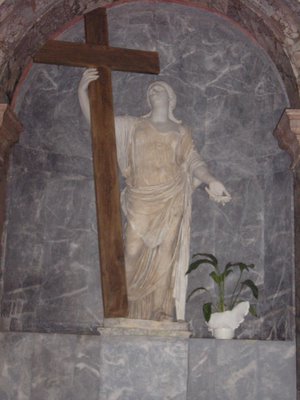Everything Old is New Again*
I mentioned Proba and her Cento in these pages recently; her poem, made up of bits of Vergil reorganized to tell the story of Christ, is a fascinating example of Late Antique Christian adaptation and appropriation of the classical past. I think that the statue pictured below demonstrates a similar phenomenon in the visual arts, though this adaptation did not, as far as I know, occur in Late Antiquity–I do not know when it was remade, but I assume that it was perhaps in the Renaissance. The statue sits in the Roman basilica of Santa Croce in Gerusalemme (other names are Basilica Eleniana or Basilica Sessoriana, which claims to preserve fragments of the True Cross as relics brought back from Jerusalem by Constantine’s mother Helena, along with some earth from Calvary. The basilica sits on the grounds of a 3rd-century imperial villa begun by Septimius Severus and completed by Heliogabalus, which served as Helena’s private residence. She is thought to have dedicated a room of the building for Christian worship and, perhaps around a decade later, an atrium of the building was turned into a Christian basilica.
Anyway, back to the statue. This work, found at Ostia, was originally a statue of Juno and was then transformed into a figure of Helena by replacing the head and arms and adding a cross.
*Information for this post was taken from the Blue Guide for Rome, the Guida d’Italia: Roma, and the Eyewitness Travel Guide for Rome.


No comments:
Post a Comment